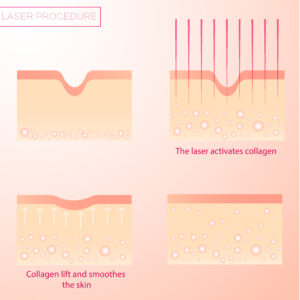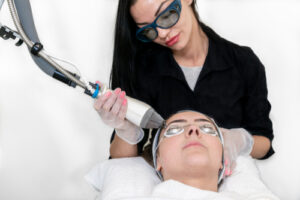Are you looking to reclaim your youthful appearance? Feeling like you look older than you are can often begin with how your skin appears.
By targeting fine lines and wrinkles, you’ll be fast-tracking your way to fighting off aging. You can use creams and various moisturizers to accomplish this.
If you want a more modern approach that’s also faster, laser technology may be the way to go. Lasers are not only more effective, but they can give you the results you’re looking for.
Lasers are used in many different ways in medicine and are particularly useful in cosmetology. Keep reading to learn more about what laser skin resurfacing accomplishes and how it can help you look more like yourself!
How Does Laser Skin Resurfacing Work?
Laser skin resurfacing is a procedure that reduces imperfections in the skin. It does this by applying ultra pulsed light beams to the skin.
Using these light beams causes the removal of thin layers of skin. You can do this without damaging the rest of the area from the heat emitted by the laser.
Laser skin resurfacing has been used for many years to treat various skin conditions, even for cancerous growths. New methods and tech have since evolved, allowing us to deliver astonishing results more gently.
Some laser skin resurfacing processes use an ablative method. When ablating the skin, it only damages the skin slightly. The process then promotes new collagen to form.
At Ellis Eye, we use a non-ablative treatment to remove wrinkles, warts, enlarged pores, and even scar tissue. It accomplishes this by stimulating collagen growth without being overly invasive.
Stimulating collagen growth reduces recovery time, so you don’t have to worry about red, splotchy skin after you heal. Collagen is a necessary ingredient to the success of any skincare routine.
It is a robust and flexible protein found in everything from hair to bones and, of course, in your skin. It keeps your skin from sagging, but as you get older, you also decrease your production of it, making you look less youthful.
Preparing Before Laser Resurfacing
For the best results, be careful to avoid excessive exposure to the sun in the months before your procedure. Spending too much time in the sun could damage your skin and may cause permanent irregular pigmentation in areas treated.
You should also discontinue smoking for at least two weeks to optimize your results. Other things to avoid include aspirin or blood thinners, perfumes, or anything else that might irritate the treatment zones.
Make sure you have a friend or trusted family member that can drive you home, as you aren’t allowed to operate a vehicle after having laser resurfacing.
What Happens During the Procedure?
Before you attend your laser procedure, you’ll need to let the doctor know about your medical history and any current medications you are on. You also need to inform them about any past cosmetic procedures you’ve undergone.
If you’ve had a history of oral infections, you may need to discuss taking antiviral medication before you can begin a laser resurfacing procedure. Your doctor will also perform a brief but thorough examination of the skin in the desired area.
During this examination, they will take notes on the tone and thickness of your skin.
At Ellis Eye, we use a CO2 laser when performing laser resurfacing procedures. CO2 lasers use carbon dioxide without ablation to remove facial imperfections.
Laser resurfacing is an outpatient treatment, meaning you can go home the same day you have it performed. Before your laser resurfacing procedure begins, your doctor may numb the area using a local anesthetic to ensure you don’t feel any pain.
How much they use will depend on if you’re treating parts of your face or your entire face. If you only choose to have a specific amount of your face treated, the process takes about 30-45 minutes.
Getting a complete face treatment can take up to two hours.
Recovery
For many patients, getting laser skin resurfacing feels like having a mild sunburn. It shouldn’t take too long to recover after having laser skin resurfacing, especially the non-ablative kind.
Most patients can return to work right away. Remember that the actual improvement to your skin will take some time, as the collagen needs time to grow and replicate.
You will likely experience some redness, but it will be safe to cover up with makeup once it has healed sufficiently. Using a green-based foundation and concealer will help tone down the intensity of any redness.
Also, look for oil-free makeup to keep your pores from getting clogged while you’re healing. Make sure to ask your doctor when it’s safe to wear makeup again.
Any treated areas are likely to peel. The newly rejuvenated skin may be pink, but it should lighten gradually over several months.
Make sure you moisturize the affected area thoroughly as recommended by your doctor. You may also notice some swelling, but you can avoid this by not sleeping on the treatment site. You can also elevate your head using an extra pillow at night.
Pain is usually minimal, but if you are experiencing pain during your recovery, cold compresses can help to alleviate it. You will also be particularly susceptible to sun exposure, so make sure to wear strong sunscreen when spending time outdoors.
In rare cases, complications can include scarring and swelling, but this typically is not the case. Depending on how severe your skin condition that you had treated was, it will likely take 2 to 3 weeks for the areas to heal.
If looking young is important to you, laser skin resurfacing could be the answer! Set up an appointment at Ellis Eye in San Jose, CA, to find out more about laser skin resurfacing and if it could be the answer to your skin concerns!





